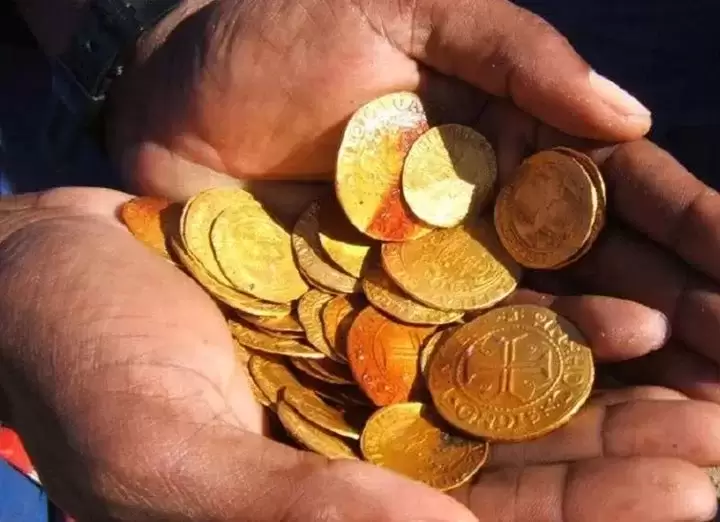 |
|
 |
|
 |
|
 |
|
 |
|
 |
|
 |
|
 |
|
 |
|
 |
|
 |
|
 |
|
 |
|
 |
|
 |
|
Cryptocurrency News Articles
Lost at Sea, Found in the Sand: Unearthing a 500-Year-Old Shipwreck in Namibia
Apr 01, 2025 at 09:32 pm
A Portuguese vessel lost in 1533 resurfaced in Namibia's desert, offering a treasure trove of coins, ingots, and a glimpse into global trade history. By Kele Johnson.

A Portuguese vessel lost in 1533 has recently resurfaced in Namibia’s desert, offering a treasure trove of coins, ingots, and a glimpse into global trade history.
Miners searching for diamonds in one of the most unlikely places on earth—the blazing sands of the Namib Desert—uncovered a time capsule from the Age of Discovery. They were working on a new section of the diamond mine in 2008 when they unearthed the remains of the Bom Jesus (which translates to “The Good Jesus”), a Portuguese trading vessel lost at sea nearly 500 years ago. The final voyage had ended, but not in the waters off the coast of Africa. It had ended inland, where the desert meets the Atlantic coast.
And it was filled with treasure.
The Bom Jesus was a Portuguese nau (also called a Carrack) that departed Lisbon on Friday, March 7, 1533, captained by Sir Francico de Noronha, bound for the lucrative trade routes of the East. The ship’s fate remained a mystery for centuries—until 2008, when diamond miners discovered its wreck near Oranjemund on Namibia’s Atlantic coast. Its discovery marked a milestone in maritime archaeology: the Bom Jesus is now considered the oldest and most significant shipwreck found along the western edge of Sub-Saharan Africa.
Built in the early 16th century during Portugal’s golden age of exploration, the Bom Jesus likely belonged to a new generation of ships designed to endure the long and perilous voyages between Europe and Asia. These naus were built larger and sturdier than earlier vessels, being built to withstand the treacherous passage around the Cape of Good Hope and back.
The hull of the Bom Jesus was constructed using advanced shipbuilding techniques for the time. It was a vessel of considerable size and draft, a testament to the Portuguese prowess in shipbuilding during the Age of Discovery.
Although little documentation of the ship survives, experts believe the Bom Jesus was headed for the Indian subcontinent, carrying a cargo tailored for trade.
The archaeologists called to the site uncovered an staggering hoard. Approximately 2,000 gold coins were recovered from the site, predominantly Spanish excellentes featuring the likenesses of Isabella I of Castile and Ferdinand II of Aragon. Portuguese coinage was also present, including cruzados from the reigns of Kings Manuel I and João III. Additionally, coins from Venice, France, and various Muslim states were found, indicative of the extensive trade connections of the period. The inscriptions and designs on these coins were instrumental in dating the shipwreck to the early 1530s.
Another surprise came in bulk. The find included 1,845 copper ingots, each stamped with a trident mark linking them to the powerful Fugger banking family of Germany, which were found amidst the wreckage. These ingots, weighing some 17 tons, had originally been shipped from Central Europe and were headed for India, where copper was a prized trade commodity. The Fuggers’ mark made this historical find even richer, providing substantial proof of copper’s role in global commerce and the Fugger family’s significant role in supplying copper for trade during the Renaissance.
The preservation was extraordinary. While only a small part of the wreck’s original structure was preserved, the ship’s contents were found in relatively good condition. Namibia’s dry climate and the heavy copper cargo helped create a sealed environment, protecting not just the metal but also elephant tusks, navigational instruments, weapons (including a 500-year-old musket and cannons), and personal effects—all eerily well-preserved.
Dr. Dieter Noli, the lead archaeologist at the South African Institute for Maritime Archaeological Research, maintains that the copper ingots were responsible for the remarkable preservation of the ship’s cargo. “Marine organisms may like wood, book covers, peach pits, jute sacks, and leather shoes, but copper really repels them from their food – so a lot of things survived 500 years at the bottom of the sea that really shouldn’t have.”
The find is the stuff of legend for treasure hunters and history buffs. For numismatists, it’s a windfall of study materials and historical significance.
Seventeen years after its discovery, the exact fate of the Bom Jesus and how it came to rest in Namibia is still uncertain. The prevailing theory is that a violent storm pushed the ship toward the coast, where it ran aground.
Though many items remain in conservation, plans are to exhibit the Bom Jesus artifacts to the public eventually. In the meantime, the find continues to offer new clues about a time when ships like the Bom Jesus helped stitch together a truly global economy.
Disclaimer:info@kdj.com
The information provided is not trading advice. kdj.com does not assume any responsibility for any investments made based on the information provided in this article. Cryptocurrencies are highly volatile and it is highly recommended that you invest with caution after thorough research!
If you believe that the content used on this website infringes your copyright, please contact us immediately (info@kdj.com) and we will delete it promptly.
-

- Introducing CREcoin: The Meme Coin Governance Token Hybrid Revolutionizing Real Estate
- Apr 03, 2025 at 03:15 am
- CREcoin isn't your average token. It's a meme coin governance token hybrid that gives YOU the power to influence the future of a professionally managed real estate portfolio worth millions.
-

-

-

- Glossi Token Promises to Make Waves in the Cryptocurrency World in 2025 by Combining AI, Metaverse, Web 3.0, NFT, DeFi, and Gaming into a Single Multi-Utility Digital Asset
- Apr 03, 2025 at 03:10 am
- Glossi Token is set to make waves in the cryptocurrency world in 2025, combining AI, Metaverse, Web 3.0, NFT, DeFi, and Gaming into a single multi-utility digital asset.
-

-

-

- Justin Sun Reveals First Digital Trust (FDT) Is Effectively Insolvent
- Apr 03, 2025 at 03:00 am
- In a surprising turn of events, Justin Sun, a prominent figure within the Tron (TRX) ecosystem, has revealed that First Digital Trust (FDT), a tech-driven financial institution based in Hong Kong, is effectively insolvent and unable to cover its obligations.
-

- Techteryx, the firm behind TrueUSD, required a loan from Justin Sun after its reserves became stuck in First Digital Trust
- Apr 03, 2025 at 03:00 am
- Court filings in Hong Kong and reporting from CoinDesk have revealed that Techteryx, the firm behind TrueUSD, required a loan from Justin Sun after its reserves became stuck in First Digital Trust and it became effectively insolvent.
-






























































